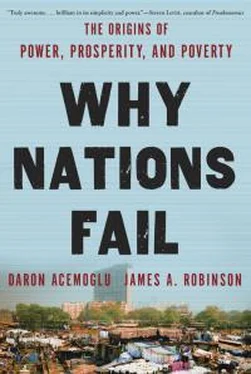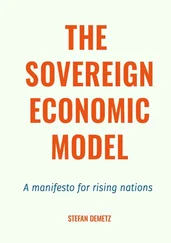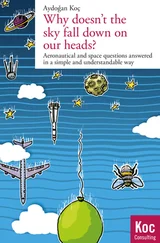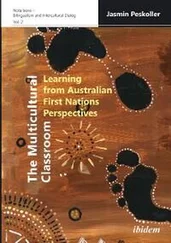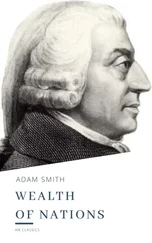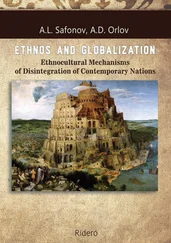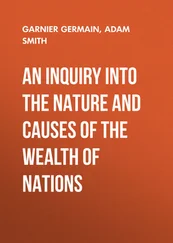This book will show that while economic institutions are critical for determining whether a country is poor or prosperous, it is politics and political institutions that determine what economic institutions a country has. Ultimately the good economic institutions of the United States resulted from the political institutions that gradually emerged after 1619. Our theory for world inequality shows how political and economic institutions interact in causing poverty or prosperity, and how different parts of the world ended up with such different sets of institutions. Our brief review of the history of the Americas begins to give a sense of the forces that shape political and economic institutions. Different patterns of institutions today are deeply rooted in the past because once society gets organized in a particular way, this tends to persist. We’ll show that this fact comes from the way that political and economic institutions interact.
This persistence and the forces that create it also explain why it is so difficult to remove world inequality and to make poor countries prosperous. Though institutions are the key to the differences between the two Nogaleses and between Mexico and the United States, that doesn’t mean there will be a consensus in Mexico to change institutions. There is no necessity for a society to develop or adopt the institutions that are best for economic growth or the welfare of its citizens, because other institutions may be even better for those who control politics and political institutions. The powerful and the rest of society will often disagree about which set of institutions should remain in place and which ones should be changed. Carlos Slim would not have been happy to see his political connections disappear and the entry barriers protecting his businesses fizzle—no matter that the entry of new businesses would enrich millions of Mexicans. Because there is no such consensus, what rules society ends up with is determined by politics: who has power and how this power can be exercised. Carlos Slim has the power to get what he wants. Bill Gates’s power is far more limited. That’s why our theory is about not just economics but also politics. It is about the effects of institutions on the success and failure of nations—thus the economics of poverty and prosperity; it is also about how institutions are determined and change over time, and how they fail to change even when they create poverty and misery for millions—thus the politics of poverty and prosperity.
2.
THEORIES THAT DON’T WORK
THE LAY OF THE LAND
THE FOCUS OF our book is on explaining world inequality and also some of the easily visible broad patterns that nest within it. The first country to experience sustained economic growth was England—or Great Britain, usually just Britain, as the union of England, Wales, and Scotland after 1707 is known. Growth emerged slowly in the second half of the eighteenth century as the Industrial Revolution, based on major technological breakthroughs and their application in industry, took root. Industrialization in England was soon followed by industrialization in most of Western Europe and the United States. English prosperity also spread rapidly to Britain’s “settler colonies” of Canada, Australia, and New Zealand. A list of the thirty richest countries today would include them, plus Japan, Singapore, and South Korea. The prosperity of these latter three is in turn part of a broader pattern in which many East Asian nations, including Taiwan and subsequently China, have experienced recent rapid growth.
The bottom of the world income distribution paints as sharp and as distinctive a picture as the top. If you instead make a list of the poorest thirty countries in the world today, you will find almost all of them in sub-Saharan Africa. They are joined by countries such as Afghanistan, Haiti, and Nepal, which, though not in Africa, all share something critical with African nations, as we’ll explain. If you went back fifty years, the countries in the top and bottom thirty wouldn’t be greatly different. Singapore and South Korea would not be among the richest countries, and there would be several different countries in the bottom thirty, but the overall picture that emerged would be remarkably consistent with what we see today. Go back one hundred years, or a hundred and fifty, and you’d find nearly the same countries in the same groups.
Map 3 shows the lay of the land in 2008. The countries shaded in the darkest color are the poorest in the world, those where average per-capita incomes (called by economists GDP, gross domestic product) are less than $2,000 annually. Most of Africa is in this color, as are Afghanistan, Haiti, and parts of Southeast Asia (for example, Cambodia and Laos). North Korea is also among this group of countries. The countries in white are the richest, those with annual income per-capita of $20,000 or more. Here we find the usual suspects: North America, western Europe, Australasia, and Japan.
Another interesting pattern can be discerned in the Americas. Make a list of the nations in the Americas from richest to poorest. You will find that at the top are the United States and Canada, followed by Chile, Argentina, Brazil, Mexico, and Uruguay, and maybe also Venezuela, depending on the price of oil. After that you have Colombia, the Dominican Republic, Ecuador, and Peru. At the bottom there is another distinct, much poorer group, comprising Bolivia, Guatemala, and Paraguay. Go back fifty years, and you’ll find an identical ranking. One hundred years: same thing. One hundred and fifty years: again the same. So it is not just that the United States and Canada are richer than Latin America; there is also a definite and persistent divide between the rich and poor nations within Latin America.
A final interesting pattern is in the Middle East. There we find oil-rich nations such as Saudi Arabia and Kuwait, which have income levels close to those of our top thirty. Yet if the oil price fell, they would quickly fall back down the table. Middle Eastern countries with little or no oil, such as Egypt, Jordan, and Syria, all cluster around a level of income similar to that of Guatemala or Peru. Without oil, Middle Eastern countries are also all poor, though, like those in Central America and the Andes, not so poor as those in sub-Saharan Africa.
While there is a lot of persistence in the patterns of prosperity we see around us today, these patterns are not unchanging or immutable. First, as we have already emphasized, most of current world inequality emerged since the late eighteenth century, following on the tails of the Industrial Revolution. Not only were gaps in prosperity much smaller as late as the middle of the eighteenth century, but the rankings which have been so stable since then are not the same when we go further back in history. In the Americas, for example, the ranking we see for the last hundred and fifty years was completely different five hundred years ago. Second, many nations have experienced several decades of rapid growth, such as much of East Asia since the Second World War and, more recently, China. Many of these subsequently saw that growth go into reverse. Argentina, for example, grew rapidly for five decades up until 1920, becoming one of the richest countries in the world, but then started a long slide. The Soviet Union is an even more noteworthy example, growing rapidly between 1930 and 1970, but subsequently experiencing a rapid collapse.
What explains these major differences in poverty and prosperity and the patterns of growth? Why did Western European nations and their colonial offshoots filled with European settlers start growing in the nineteenth century, scarcely looking back? What explains the persistent ranking of inequality within the Americas? Why have sub-Saharan African and Middle Eastern nations failed to achieve the type of economic growth seen in Western Europe, while much of East Asia has experienced breakneck rates of economic growth?
Читать дальше
